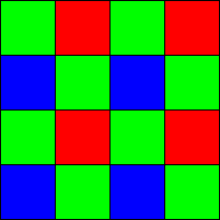Bryce Bayer
| Bryce Bayer | |
|---|---|
| Born |
Bryce E. Bayer August 15, 1929 Portland, Maine |
| Died |
November 13, 2012 (aged 83) Bath, Maine |
| Citizenship | United States |
| Institutions | Kodak |
| Alma mater |
University of Maine (B.S., Engineering Physics) University of Rochester (M.S., Industrial Statistics) |
| Known for | Bayer filter |
Bryce E. Bayer (/ˈbaɪər/; pronounced BYE-er, August 15, 1929[1] – November 13, 2012) was an American scientist who invented the Bayer filter,[1] which is used in most modern digital cameras.[1] He has been called "the maestro without whom photography as we know wouldn't have been the same."[1] Without his filter, Larry Scarff, a former chairman of the Camera Phone Image Quality Standards Group, told the New York Times after Bayer's death, "we'd still be getting only black-and-white pictures from our digital cameras."[2]
Early life and education
Bryce Edward Bayer was born in Portland, Maine, on August 15, 1929, to Alton and Marguerite Willard Bayer. As a boy he tinkered with Brownies and other cameras. He graduated in 1947 from Deering High School in Portland, where he spent a good deal of time in the school darkroom. "He, in fact, processed all of the pictures for his high school yearbook," his son David told the New York Times following Bayer's death.[2]
After receiving a bachelor's degree in engineering physics from the University of Maine in 1951, Bayer moved to Rochester, New York, to work as a research scientist at Eastman Kodak, where he would remain until his retirement in 1986. At Kodak he met Joan Fitzgerald, a fellow researcher; they were married in 1954. Bayer pursued further studies at the University of Rochester, from which he earned a master's degree in industrial statistics in 1960.[2]
Bayer filter

In 1974, while working for Kodak, Bayer completed his design for the Bayer filter, for which he filed a patent application in 1975 and in 1976 received U.S. patent number 3,971,065. The filter employs what is called the "Bayer Pattern," a checkerboard-like arrangement of red, green, and blue pixels on a square grid of photosensors that allows digital cameras to capture vivid color images. Half of the pixels collect green light, and the others are evenly divided between red and blue light.[3] The patent application described the filter as "a sensing array for color imaging" that "includes individual luminance- and chrominance-sensitive elements that are so intermixed that each type of element...occurs in a repeated pattern with luminance elements dominating the array."[4]

"The pattern is very simple," Ken Parulski, former chief scientist for Kodak's digital camera division, told the New York Times after Bayer's death. "There are twice as many green elements as red or blue because this mimics the way the human eye provides the sharpest overall color image." Parulski added that although dozens of other patterns have since been devised, including some by Parulski himself, "the Bayer pattern has stood the test of time." Larry Scarff, a former chairman of the Camera Phone Image Quality Standards Group, told the Times that "Ninety-nine point nine-nine percent of all digital cameras — cellphones, pocket cameras, webcams and consumer digital video cameras — use the Bayer pattern to produce color pictures."[2] One commentator said that Bayer's filter "marked a significant paradigm shift in the way we view and capture images." Dr. Terry Taber, Kodak Vice President and Chief Technology Officer has said that the "elegant colour technology invented by Bryce Bayer is behind nearly every digital image captured today."[1]
According to the Rochester Democrat and Chronicle, Bayer's work on the filter "helped pave the way for the development of the first working digital camera a year later." Steve Sasson, co-inventor of the first digital camera, told the Rochester newspaper "that Bayer's contributions were not only pioneering but prophetic." "We weren't even thinking about digital cameras in those days," Sasson said. "Bryce was trying to figure out how to capture color with a two-dimensional array of color-blind sensors, and that turned out to be one of the foundations of digital imaging. He was solving a fundamental problem before that problem was even upon us." Sasson added that "Bryce has always been a hero for me." Parulski told the Democrat and Chronicle that he felt "very lucky to have worked with Bryce, starting on my very first day at Kodak....Bryce was so modest and unassuming, it took me years to realize what a genius he really was." Parulski added "that Bayer's invention is the key reason we have cameras that are compact yet provide sharp-looking pictures."
Other professional activities
Bayer's contribution to photography also included algorithms that play a crucial role in storing, enhancing, and printing digital images.[5]
Honors and awards
Bayer was awarded the Royal Photographic Society's Progress Medal in 2009 given "in recognition of any invention, research, publication or other contribution which has resulted in an important advance in the scientific or technological development of photography or imaging in the widest sense." In 2012, Bayer received the first Camera Origination and Imaging Medal from the Society of Motion Picture and Television Engineers.[2]
Personal life and death
Bayer and his wife had two sons, Douglas and David, and a daughter, Janet. Bayer died on November 13, 2012, in Bath, Maine, of "a long illness related to dementia," his son Douglas told the New York Times.[2]
See also
References
- 1 2 3 4 5 "Bidding adieu to a master inventor". Fot Flock by Epson. Retrieved 22 May 2013.
- 1 2 3 4 5 6 Hevesi, Dennis. "Bryce Bayer, Inventor of a Filter to Make Color Digital Pictures, Dies at 83". New York Times. Retrieved 22 May 2013.
- ↑ "Bryce Bayer RIP (Bayer Filter/ sensor Kodak scientist)". FX Guide. Retrieved 22 May 2013.
- ↑ "Color Imaging Array". Eastman Kodak Company. Retrieved 22 May 2013.
- ↑ Havlik, Dan. "Bryce Bayer, Kodak scientist who created ubiquitous Bayer Filter for color digital imaging, has passed away". Imaging-Resource. Retrieved 22 May 2013.